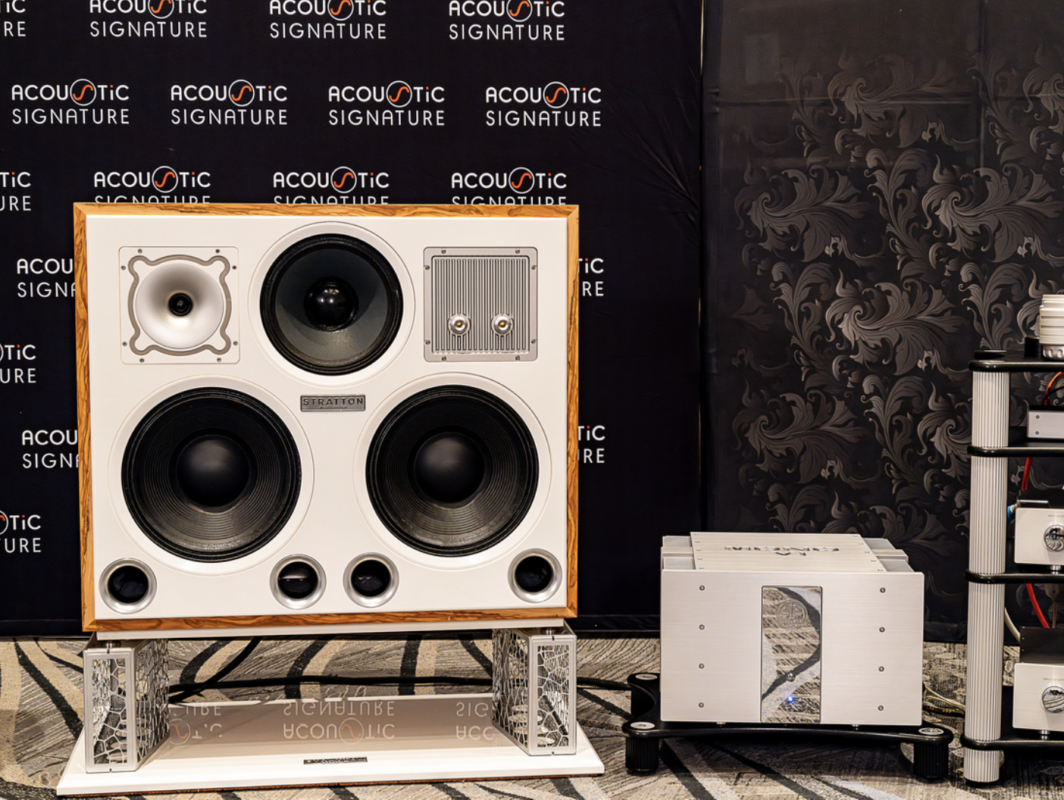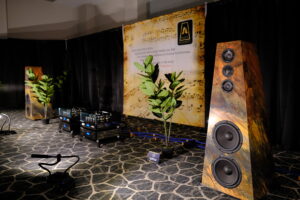
Reflections
Next year, attendees of RMAF will enjoy a revitalized Denver Marriot Tech Center courtesy of a massive renovation. Or at least half a renovation—the remainder of the complex is set for completion in 2017. Deeply in need of a makeover, the Marriot’s burnt-orange carpeting, the Starsky and Hutch era wallpaper and fixtures will finally receive the tender ministrations of the hammer and paintbrush. All of which got me thinking about obsolescence. Exhibit one, the Red Book compact disc. This year, CD players were in even shorter supply in exhibitor’s rooms than in recent years. Obviously they’ve given way to computer-server-based audio and “back-from-the-dead” LP playback. But not so fast. I still bore witness to some stunning displays of so-called “inferior” 16-bit/44kHz sound that often rivaled some of the better high-res that is currently being offered.
It occurred to me that as audiophiles (as a society in general) we are awfully quick to kick the tried and true to the curb in pursuit of the latest, greatest thing—often without thinking about what exactly we are leaving behind. For example, recall what the compact disc and its corporate enablers did to the LP just a few decades ago. Now the tables have turned and the CD is falling from favor. Yet the reality is that there are hundreds of millions of shiny silver discs out there—a freaking lot of wonderful music and performances. But just like analog LP playback, technology has come to the rescue. Add a superior modern DAC to an existing player with a digital out, and the format is sonically reborn. I’m hearing this every time I boot up the Esoteric K-03X CD/SACD player (review forthcoming). We’ve already learned the lesson with vinyl playback: that with a little help from modern technology, there was a lot more to be discovered deep in those grooves. So what about those “bits?” Perhaps the market has already spoken but my two cents says that it would be a mistake to give another physical medium a premature burial. For RMAF 2015, my beat was solid-state electronics. Here is Part 1 of my coverage.
Most Significant Introductions

Jeff Rowland Design Group Daemon ($38,800)
Last seen in static display at CES, Daemon, the 1500Wpc mega-integrated from Jeff Rowland, was up and running and sweetly singing through a chain of superb gear that included the Bergmann turntable, YG Acoustics Sonja 1.2 loudspeakers and Nordost cabling. Normally I’m not used to seeing anything less than a full stack of Rowland gear, but the Daemon effortlessly made its case for an uncompromisingly high-end one-box option.

Aesthetix Atlas Saturn Eclipse Amplifier ($15,000)
Apex Audio partnered with Musical Surroundings to premiere the new Jim White-designed Aesthetix Atlas Saturn Eclipse. The 200Wpc amp now uses new Stealthcap capacitors; super-matched, distributed-node, bipolar output devices (16 per channel); and improved grounding and superior power supply mechanical isolation on new specially designed isolation mounts. Driving a system comprising the AMG Giro turntable with 9W2 arm and Teatro cartridge, Aesthetix Calypso Eclipse linestage with Rhea Eclipse phonostage, Focal Sopra loudspeakers, and Nordost Valhalla V2 cabling, I listened to the superb Acoustic Sounds reissue of Rickie Lee Jones’ “Show Biz Kids.” The system had an organic, warm, and articulate clarity that made me sit up and take notice—for all the right reasons. Look for a monoblock version at CES.

Vinnie Rossi VR120 Power Amp ($4995)
Vinnie Rossi debuted its VR120 power amp, which delivers 120Wpc (8 ohms) in stereo and over 250W (8 ohms) in bridge-mode. Its low impedance stability allows it to drive even the most difficult speaker loads. Like the well-reviewed LIO preamp, it uses VR’s ultracapacitor power-supply technology, which is so capable of isolating audio circuitry from noise and distortion that VR claims it eliminates the need for pricey power conditioners. The sonics were superb as the VR120 handily drove the reference-caliber Harbeth 40.2 speakers through a chain that included the Acoustic Signature Challenger ’table with TA 1000 tonearm and Dynavector XX-2 cartridge, and Tellurium cabling.

PS Audio BHK Signature Preamp ($TBD)
Designed by Bascom King the BHK Signature Preamplifier is a full-function linestage that includes a discrete Class A MOSFET headphone amplifier. It’s based on a pair of zero-feedback 12AU7 vacuum tubes that feed a Class A MOSFET output stage. As with the BHK amps, high-end icon Arnie Nudell was actively involved in the voicing of the preamp. It was exhibited in an all-PS Audio system which included the PerfectWave Memory Player transport, DirectStream DAC, P10 Power Plant regenerator, BHK Signature 300 mono amplifiers, and YG Acoustics Sonja 1.3 loudspeakers. Cabling was by MG Audio Design. Shipping should commence Q2.

Quad Artera Play and Stereo ($2199 & $2299)
The sleek and stylish Quad Artera Series includes the Stereo amplifier and Play digital/analog preamp. With textured aluminum front panels, thick glass top, and CNC-routed heatsinks, the system is beyond handsome and structurally crafted to eliminate spurious resonances. The front panel uses an intuitive touch-sensitive control, while the amp produces 140Wpc courtesy of Quad’s patented Current Dumping technology. The Artera Play is a linestage with a built-in DAC and CD transport. There’s a similarly simple interface that handles ultra-high-resolution playback up to 32bit/384kHz in addition to DSD64/128/256 files through the USB input. A new slot-loading CD mechanism buffers data read from the disc before feeding it asynchronously, for minimum jitter, to the ESS9018 8-channel DAC chip.
Best of Show
Best Sound (Cost No Object)
There were bigger, pricier exhibits but for sheer musicality I still thought the room hosted by dCS/VTL/Brinkmann/Nordost and Wilson Audio packed more music and emotion than all but a select handful of the big boys. Anchored by the Wilson Sabrina, the sound was sweet, lucid, and refined. The room volume could easily have overwhelmed the most diminutive of Wilson floorstanders—but it didn’t.
Best Sound (For the Money)
Former TAD helmer Andrew Jones, now with Elac, not only wowed audiences at Newport with the impossibly cheap ($229/pr.), compact Debut B5 (review forthcoming), but returned to RMAF with its big brother, the F5—a powerhouse three-way floorstander at a ludicrously paltry $558/pr. With the speakers driven by the new and stylish Audio Alchemy electronics, even jaded audio critics could be seen shaking their heads in disbelief.
Most Significant Product Introduction
Back in a big way is Audio Alchemy with its new small chassis series. Led by Peter Madnick, credited with designing many of AA’s first-generation efforts, Audio Alchemy is offering a line of affordable, classy designs with excellent fit and finish that are going to make them highly desirable for all tastes.
Most Significant Trend
Perhaps too early and too expensive to call it a trend, but could battery power be making a comeback? The folks behind the StromTank S 5000 would like us to think so. The ability to listen for eight hours off the dirty old grid is pretty appealing. Does Tesla’s Elon Musk know about this?
Most Coveted Product
Being an integrated amp aficionado how could I not be smitten by the Jeff Rowland Design Group Daemon? Massive 1500Wpc power, 5” x 7” -touchscreen-controlled gorgeousness, cutting-edge connectivity, and build-quality that goes beyond the sublime…I’m feeling faint.
Continue to part 2 of this report here.

By Neil Gader
My love of music largely predates my enthusiasm for audio. I grew up Los Angeles in a house where music was constantly playing on the stereo (Altecs, if you’re interested). It ranged from my mom listening to hit Broadway musicals to my sister’s early Bob Dylan, Joan Baez, Beatles, and Stones LPs, and dad’s constant companions, Frank Sinatra and Tony Bennett. With the British Invasion, I immediately picked up a guitar and took piano lessons and have been playing ever since. Following graduation from UCLA I became a writing member of the Lehman Engel’s BMI Musical Theater Workshops in New York–working in advertising to pay the bills. I’ve co-written bunches of songs, some published, some recorded. In 1995 I co-produced an award-winning short fiction movie that did well on the international film-festival circuit. I was introduced to Harry Pearson in the early 70s by a mutual friend. At that time Harry was still working full-time for Long Island’s Newsday even as he was writing Issue 1 of TAS during his off hours. We struck up a decades-long friendship that ultimately turned into a writing gig that has proved both stimulating and rewarding. In terms of music reproduction, I find myself listening more than ever for the “little” things. Low-level resolving power, dynamic gradients, shadings, timbral color and contrasts. Listening to a lot of vocals and solo piano has always helped me recalibrate and nail down what I’m hearing. Tonal neutrality and presence are important to me but small deviations are not disqualifying. But I am quite sensitive to treble over-reach, and find dry, hyper-detailed systems intriguing but inauthentic compared with the concert-going experience. For me, true musicality conveys the cozy warmth of a room with a fireplace not the icy cold of an igloo. Currently I split my time between Santa Fe, New Mexico and Studio City, California with my wife Judi Dickerson, an acting, voice, and dialect coach, along with border collies Ivy and Alfie.
More articles from this editorRead Next From Show
See all
We Bring you Full Coverage of the 2024 AXPONA Show
- Apr 18, 2024

Best of Show: Southwest Audio Fest 2024
- Mar 18, 2024




















